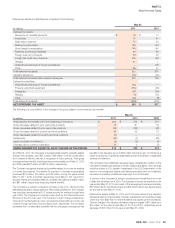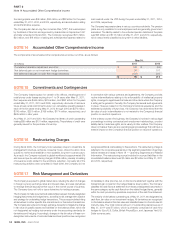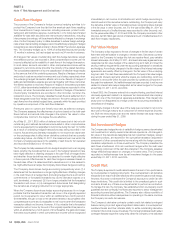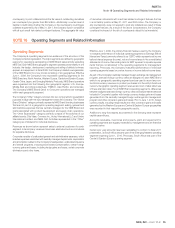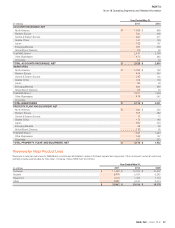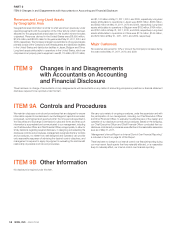Nike 2011 Annual Report Download - page 54
Download and view the complete annual report
Please find page 54 of the 2011 Nike annual report below. You can navigate through the pages in the report by either clicking on the pages listed below, or by using the keyword search tool below to find specific information within the annual report.54 NIKE,INC.-Form10-K
PARTII
Note17Risk Management and Derivatives
Cash Flow Hedges
The purpose of the Company’s foreign currency hedging activities is to
protect the Company from the risk that the eventual cash fl ows resulting
from transactions in foreign currencies, including revenues, product costs,
selling and administrative expense, investments in U.S. dollar-denominated
available-for-sale debt securities and intercompany transactions, including
intercompany borrowings, will be adversely affected by changes in exchange
rates. It is the Company’s policy to utilize derivatives to reduce foreign exchange
risks where internal netting strategies cannot be effectively employed. Hedged
transactions are denominated primarily in Euros, British Pounds and Japanese
Yen. TheCompany hedges up to 100% of anticipated exposures typically
12months in advance, but has hedged as much as 34months in advance.
All changes in fair values of outstanding cash fl ow hedge derivatives, except
the ineffective portion, are recorded in other comprehensive income until net
income is affected by the variability of cash fl ows of the hedged transaction.
In most cases, amounts recorded in other comprehensive income will be
released to net income some time after the maturity of the related derivative.
The consolidated statement of income classifi cation of effective hedge results
is the same as that of the underlying exposure. Results of hedges of revenue
and product costs are recorded in revenue and cost of sales, respectively, when
the underlying hedged transaction affects net income. Results of hedges of
selling and administrative expense are recorded together with those costs when
the related expense is recorded. Results of hedges of forecasted purchases
of U.S. dollar-denominated available-for-sale securities are recorded in other
(income), net when the securities are sold. Results of hedges of forecasted
intercompany transactions are recorded in other (income), net when the
transaction occurs. The Company classifi es the cash fl ows at settlement from
these designated cash fl ow hedge derivatives in the same category as the
cash fl ows from the related hedged items, generally within the cash provided
by operations component of the cash fl ow statement.
Premiums paid on options are initially recorded as deferred charges.
TheCompany assesses the effectiveness of options based on the total cash
fl ows method and records total changes in the options’ fair value to other
comprehensive income to the degree they are effective.
As of May31,2011, $120million of deferred net losses (net of tax) on both
outstanding and matured derivatives accumulated in other comprehensive
income are expected to be reclassifi ed to net income during the next 12months
as a result of underlying hedged transactions also being recorded in net
income. Actual amounts ultimately reclassifi ed to net income are dependent
on the exchange rates in effect when derivative contracts that are currently
outstanding mature. As of May31,2011, the maximum term over which the
Company is hedging exposures to the variability of cash fl ows for its forecasted
and recorded transactions is 15months.
The Company formally assesses both at a hedge’s inception and on an ongoing
basis, whether the derivatives that are used in the hedging transaction have
been highly effective in offsetting changes in the cash fl ows of hedged items
and whether those derivatives may be expected to remain highly effective
in future periods. Effectiveness for cash fl ow hedges is assessed based on
forward rates. When it is determined that a derivative is not, or has ceased to
be, highly effective as a hedge, the Company discontinues hedge accounting.
The Company discontinues hedge accounting prospectively when (1)it
determines that the derivative is no longer highly effective in offsetting changes
in the cash fl ows of a hedged item (including hedged items such as fi rm
commitments or forecasted transactions); (2)the derivative expires or is
sold, terminated, or exercised; (3)it is no longer probable that the forecasted
transaction will occur; or (4)management determines that designating
thederivative as a hedging instrument is no longer appropriate.
When the Company discontinues hedge accounting because it is no longer
probable that the forecasted transaction will occur in the originally expected
period, but is expected to occur within an additional two-month period of
time thereafter, the gain or loss on the derivative remains in accumulated other
comprehensive income and is reclassifi ed to net income when the forecasted
transaction affects net income. However, if it is probable that a forecasted
transaction will not occur by the end of the originally specifi ed time period or
within an additional two-month period of time thereafter, the gains and losses
that were accumulated in other comprehensive income will be recognized
immediately in net income. In all situations in which hedge accounting is
discontinued and the derivative remains outstanding, the Company will carry
the derivative at its fair value on the balance sheet, recognizing future changes
in the fair value in other (income), net. For the year ended May31,2011 an
immaterial amount of ineffectiveness was recorded to other (income), net.
Fortheyears ended May31,2010 and 2009, the Company recorded in other
(income), net $5million gain and an immaterial amount of ineffectiveness from
cash fl ow hedges, respectively.
Fair Value Hedges
The Company is also exposed to the risk of changes in the fair value of certain
fi xed-rate debt attributable to changes in interest rates. Derivatives currently
used by the Company to hedge this risk are receive-fi xed, pay-variable
interest rate swaps. As of May31,2011, all interest rate swap agreements are
designated as fair value hedges of the related long-term debt and meet the
shortcut method requirements under the accounting standards for derivatives
and hedging. Accordingly, changes in the fair values of the interest rate swap
agreements are exactly offset by changes in the fair value of the underlying
long-term debt. The cash fl ows associated with the Company’s fair value hedges
are periodic interest payments while the swaps are outstanding, which are
refl ected in net income within the cash provided by operations component of
the cash fl ow statement. No ineffectiveness has been recorded to net income
related to interest rate swaps designated as fair value hedges for theyears
ended May31,2011,2010, and 2009.
In fi scal 2003, the Company entered into a receive-fl oating, pay-fi xed interest
rate swap agreement related to a Japanese Yen denominated intercompany
loan with one of the Company’s Japanese subsidiaries. This interest rate
swap was not designated as a hedge under the accounting standards for
derivatives and hedging.
Accordingly, changes in the fair value of the swap were recorded to net income
each period through maturity as a component of interest expense (income),
net. Both the intercompany loan and the related interest rate swap matured
during the year ended May31,2009.
Net Investment Hedges
The Company also hedges the risk of variability in foreign-currency-denominated
net investments in wholly-owned international operations. All changes in
fair value of the derivatives designated as net investment hedges, except
ineffective portions, are reported in the cumulative translation adjustment
component of other comprehensive income along with the foreign currency
translation adjustments on those investments. The Company classifi es the
cash fl ows at settlement of its net investment hedges within the cash used
by investing component of the cash fl ow statement. The Company assesses
hedge effectiveness based on changes in forward rates. The Company
recorded no ineffectiveness from its net investment hedges for theyears
ended May31,2011,2010, and 2009.
Credit Risk
The Company is exposed to credit-related losses in the event of non-performance
by counterparties to hedging instruments. The counterparties to all derivative
transactions are major fi nancial institutions with investment grade credit ratings.
However, this does not eliminate the Company’s exposure to credit risk with
these institutions. This credit risk is limited to the unrealized gains in such
contracts should any of these counterparties fail to perform as contracted.
To manage this risk, the Company has established strict counterparty credit
guidelines that are continually monitored and reported to senior management
according to prescribed guidelines. The Company also utilizes a portfolio of
fi nancial institutions either headquartered or operating in the same countries
the Company conducts its business.
The Company’s derivative contracts contain credit risk related contingent
features aiming to protect against signifi cant deterioration in counterparties’
creditworthiness and their ultimate ability to settle outstanding derivative
contracts in the normal course of business. The Company’s bilateral credit related
contingent features require the owing entity, either the Company or the derivative







